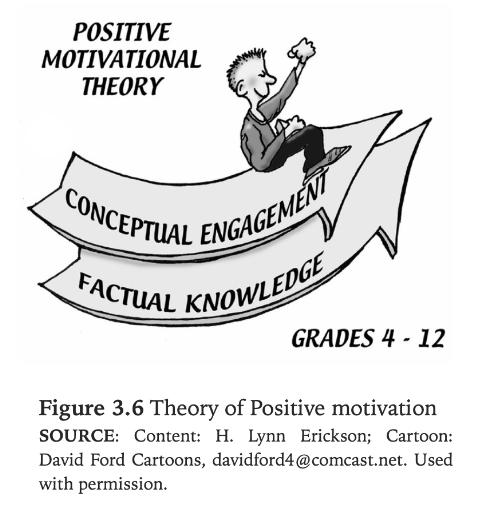Main Points Behind CBCI:
- A lot of curriculum units include having students reach a certain amount of objectives or “I Can” statements during each lesson. One would think that the more objectives met would mean the more knowledge gained, however that is not the case. With CBCI, teachers share fewer ideas in each lesson, but have the students explore the ideas with more details which makes it easier for them to remember and in the long run, they reach more goals and leave with more knowledge gained (Erickson 64). I love this approach because in doing this, it gives teachers less time to lecture and more time for students to explore and find answers to their questions.

- When teaching using the CBCI method, students have a better understanding of the material due to the nature of inquiry-based learning (24). Giving students the opportunities to explore through hands-on and minds-on activities, find the answers to open-ended questions, and make real world connections is beneficial to their educational experience inside and outside of the classroom. The responsibility of the teacher is to be a guide for the students by coaching them, asking them questions, offering feedback, and overall designing the lesson or task that helps stretch their thinking and understand the content (90). I love the student led approach and I believe that students become more motivated when they feel like they are in control of their learning and have a say in how they learn. It benefits the educators and students as a whole.
CBCI is…
- Concept Based Curriculum and Instruction is a way of teaching that allows students to have a deeper level of understanding throughout the learning process. Many curriculums focus on the knowing and doing of skills, but fail to intertwine the conceptual understanding of the skills. Having a better understanding of the skills that are being taught through CBCI helps students to use and apply what they have learned outside of the classroom. CBCI gives students the opportunities to explore, ask questions, collaborate, make mistakes, use creativity, and overall give students ownership of their learning and the way they approach it (Erickson 90).
Unit Plan Overview and Challenges:

- I am planning on creating a unit plan for Non-Fiction Writing about Bears. Students will be put into small groups and will choose which kind of bear they want to research. They will learn about the bear they have chosen through a variety of non-fiction bear books from our school library. They will research interesting facts about bears, including their diets and habitats. Using the information that they find, they will create a research report with their small group. Then they will record themselves reading their research report together in front of the green screen in our Innovation Hub where they can alter the background to look like their bear type’s habitat.
Here is the vision for bringing our research reports to life: Green Screen in Education
- The major challenges that may come with developing this unit plan is making sure that it flows well among the subjects of writing, reading, and science. Also, managing the amount of time that it takes among all of the small groups. I will need to make sure that the small groups are well balanced and that peers will be able to support each other while also having the freedom and creativity to explore and present their findings.
TCE Threshold Concepts:
TCE Threshold Concept #1: Curriculum is more than standards, textbooks, or courses of study
- CBCI is more than meeting a state standard, reading textbooks, or checking off an objective for students. It is a learning process that can meet the needs of all learners through an explorative, inquiry-based, creative approach (Erickson 187). If educators or schools are only worried about meeting state standards, they are missing the richness that can be provided through education for students. Overtime, we have found that learning beyond reading textbooks, taking exams, and doing worksheets are not catered to the variety of learners. This often causes students more stress and hatred towards the learning experience. It is so important to realize that the students that walk through the school doors everyday are more than a test score. They are creative, curious, and intellectual beings that are wired to explore and wonder. Giving students the tools, resources, and opportunities to have ownership over their learning will not only let the students direct their learning, but it will give them skills and knowledge that they can take with them beyond the classroom.

TCE Threshold Concept #2: Teaching is/as intellectual engagement
- CBCI is a learning process that is both hands-on and minds-on (196). Before teachers can even present these lessons, they must make sure that the lesson is going to be engaging, allow exploration, and ask high-level questions. They must consider the variety of learners and meet their tactile, visual, auditory, and kinesthetic needs. They have to consider the accommodations and modifications that can be made to cater to all learners in the classroom. Teaching is an intellectual engagement in planning for lessons and executing lessons. Although CBCI is very student-driven it is important for teachers to provide the outer shell of the lesson to students, circulate the classroom, check in with students, ask them questions that will inspire exploration and wonder, and observe the way students are learning. Teaching is an intellectual activity that requires a lot of planning and appropriate execution.

Hi Quanika!
Thank you for your feedback and encouraging words! I am looking forward to creating and teaching this lesson!
Hi Jade!
Thank you for the feedback! I like your suggestion of inviting a zoologist in or showing a national geographic clip of bears. I also like your suggestion of grouping the students by various abilities so that they can help each other with this project in different ways, using their strengths! Thank you!
What a cool lesson! This will definitely be one that your students will remember forever. I think it will lend itself well to the other subjects. Assigning jobs to each groups and allowing the students to choose a job within their groups will help with them working together. Also as Emma said, having a goal to achieve each day so students know what is expected of them and can self-evaluate will be very beneficial. This statement- “If educators or schools are only worried about meeting state standards, they are missing the richness that can be provided through education for students.”- is golden! Students are definitely wired to be creative, as educators, it is our job to nurture that. I love how your unit lends itself to that.
Hi Carolyn!
I enjoyed reading your blog post and hearing your ideas relating to CBCI. I am someone who enjoys the simplicity of things especially where teaching and learning are involved. In no way am I criticizing critical thinking or the necessary complexities we must learn in education but I do enjoy when even the simplest of things can hold so much knowledge and impact. I say this because after I read your ideas for your unit plan, I noticed that it didn’t seem to be so demanding upfront which shows me that there are so many different directions you can take this plan in (which is awesome)! You could have a zoologist or animal enthusiast that works/studies bears closely to come in and speak to the kids or even watch different national geographic episodes that feature bears, their habitats, and other characteristics. Your incorporation of technology with the green screen and written text for their research gives the students a good mix of resources and multimodal platforms to engage in. I also think it gives the project much more of a realistic feel when you’re able to be creative and use technologies that make the project come to life.
I’m not sure how you are grouping the students but if you know your students well enough, you could mix those who have immense creativity with those who have a true skill for writing and create a balance in the group where everybody’s knowledge is able to be considered and used equally. This will also allow the students to learn from one another and pick up skills/ideas that they can then use for future activities.
Here is a blog about bears that teaches you about their lifestyles and also the safest ways to coexist with them! https://www.bearsmart.com/about-bears/north-americas-bears/
Hi Delaney!
I completely agree! I want to make sure that my students can take the skills that they learn and use them moving forward. Thank you for the encouraging words!
Hi Carolyn!
This is a beautiful blog post. So insightful, easy to follow, and well published! You sold me on your definition of CBCI. I enjoy your comment abut students gaining a deeper understanding of the concepts and then being able to apply those concepts outside of the classroom. I often find myself feeling like my students have a good understanding of what we are doing and they can accurately answer questions in class but I am worried about their skills outside of the classroom. I believe that is my selling point on the CBCI, students being able to leave our rooms and become positive people in our society and help solve the problems we face.
In your unit plan I love your use of technology. You plan does an awesome job connecting different concepts into one assignment. I think your students will enjoy the process and get to see their hard work pay off in an innovative way! I can’t wait to see more!
Hi Emma!
Thank you for your thoughts and ideas! I would love to show an episode of We Bear Bears, thank you for that idea! I also love your suggestions of setting goals for each day of the unit and checking in with groups with an exit ticket. I definitely want to be mindful about the groups for this project and leave room for conferring, scaffolding, and enrichment among them!
Carolyn,
Your main points about CBCI were so insightful. I enjoyed reading about the importance of students exploring ideas, inquiry based learning, and developing deeper understandings throughout the learning process.
I am actually doing a similar unit as you! Mine is more focused on habitats and conservation, but I love the exploration of bears. It reminds me of a show I used to watch with my younger siblings called We Bear Bears- maybe you could show an episode to your students as an incentive. I also really like how the students are able to choose their bear to do research on, and that your school offers a green screen resource- so cute!
With your small groups, an idea for utilizing time efficiently would be to give them a goal for each day. Maybe one day, they have to find three different foods in their diet and this could serve as an exit ticket. If you have extra time, they could share their research at the end of class each day.
Also, if you wanted to differentiate your groups, you could group them together based on their learning needs. They could still choose the bear that they are interested in, but as a group. You could provide groups with the support and challenges that they need such as providing sentence starters to one group, or encouraging another group to write in more detail. Great post!